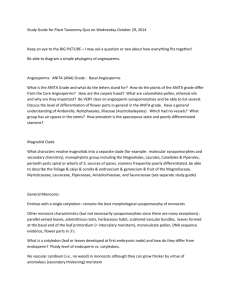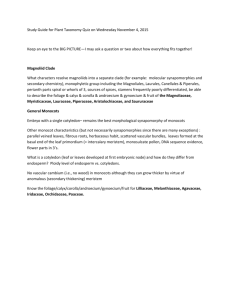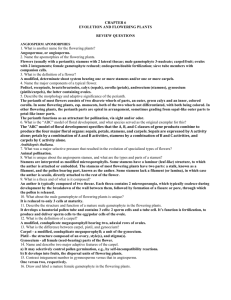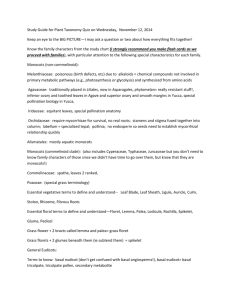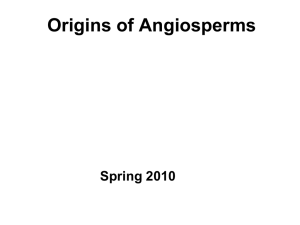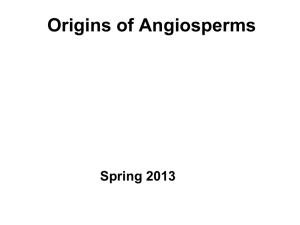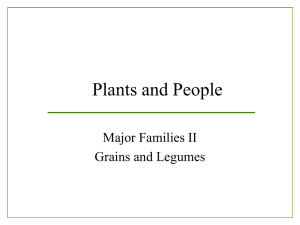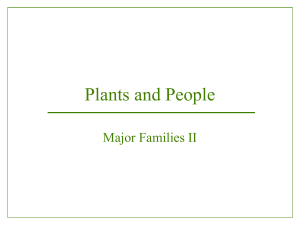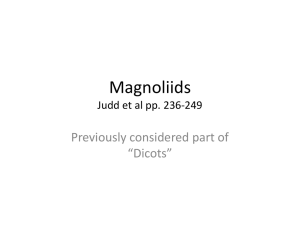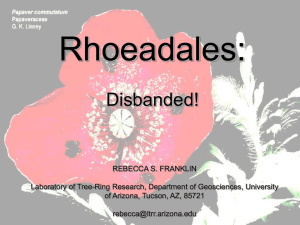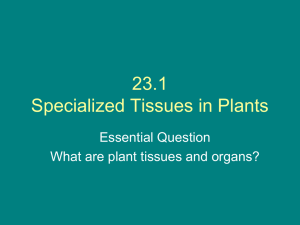ANITA Grade
advertisement
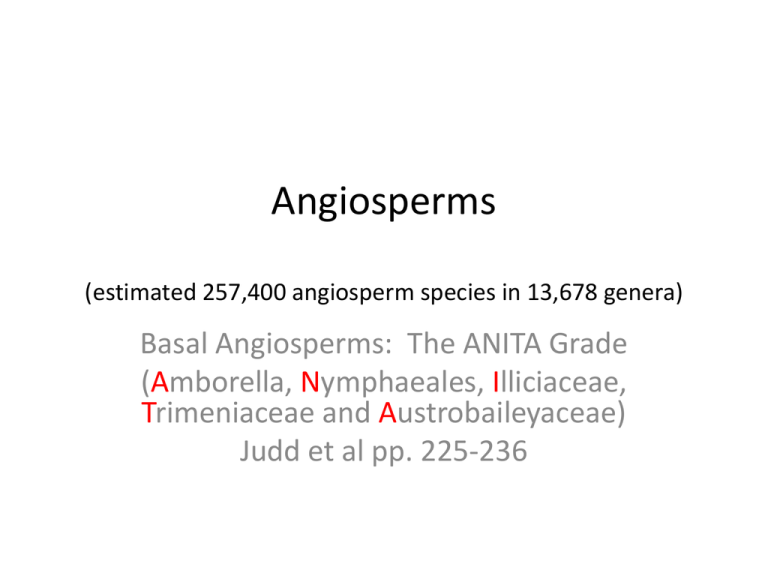
Angiosperms (estimated 257,400 angiosperm species in 13,678 genera) Basal Angiosperms: The ANITA Grade (Amborella, Nymphaeales, Illiciaceae, Trimeniaceae and Austrobaileyaceae) Judd et al pp. 225-236 ANITA Grade HYPOTHETICAL ANGIOSPERM PHYLOGENY A B C D E F ? “ANITA GRADE” Magnoliids Monocots Eudicots Angiosperm Synapomorphies • Seeds produced within a carpel with a stigmatic surface for pollen germination • Very reduced female gametophyte, consisting in most cases of just 8 nuclei in seven cells • Double fertilization • Triploid endosperm • Specialized phloem (companion cells derived from same mother cell as sieve tube elements)– though very similar to gymnosperms. Gymnosperms have sieve pores, while angiosperms have sieve plates. Sieve Elements Sieve cells are living (metabolically active), but dependent on the companion cells . “Sieve elements” refers either to sieve tube member (angiosperms) or sieve cell (gymnosperms and ferns.) Angiosperm Synapomorphies • Vessels in xylem tissue (not just tracheids; this feature probably evolved within the group however) • Many molecular features as well. Generalized Flower Parts Angiosperm Life Cycle Gametophyte of non-ANITA grade angiosperms usually has 8 cells. Flowers of Early Angiosperms (as judged by the ANITA Grade) • Insect pollinated • Radially symmetrical • Perfect (bisexual, although not Amborella) and hypogynous • Parts several to numerous • Parts free and distinct • Perianth poorly differentiated into calyx and corolla (i.e., with tepals) • Stamens poorly differentiated into anthers and filaments Flowers of Early Angiosperms (as judged by the ANITA Grade) • Pollen grains monosulcate • Carpels with poorly differentiated stigma and style • Carpel margins sealed by a secretion rather than fusion of epidermal layers as in other angiosperms. • Female gametophyte may have unusual numbers of cells and ploidy level of endosperm: most other angiosperms have an 8-nucleate female gametophyte and triploid endosperm Amborella trichopoda Amborella trichopoda: flower Lacks vessels 9-nucleate female gametophyte and triploid endosperm Shrub Stigma and style poorly differentiated Flowers unisexual, carpellate flowers have sterile stamens (staminodes) Tepals= no differentiation into sepals and petals Stamens poorly delimited between anther and filament (filament short); inner stamens frequently sterile (staminodes) Amborella trichopoda Vessel elements NO! Tracheids yes! Amborella trichopoda: other distinctive features • Fruit (Yes, our first plant with a fruit!!) is an ovoid red drupe • “More or less inaperturate pollen” J&C pg. 233 • Both insect and wind pollinated • Drupes are dispersed by birds Nymphaceae: Water Lillies Nymphaceae: Water Lillies • Either lack vessels or have intermediate tracheid-like vessel. • Tepals • Stems with conspicuous air canals • Aquatic • Tepals seem to intergrade with stamens • Stamens sometimes poorly differentiated into anther and filament Stamens Stamen poorly differentiated into filament and anther Petals seem to intergrade into stamens Nymphaceae: Water Lillies • Pollen grains usually monosulcate • Carpels distinct or connate • Some flowers attract beetles by producing heat (!) along with a strong fruity odor, flowers opening and closing daily to trap the beetles • 4 cell/4 nucleus female gametophyte and diploid endosperm! Nymphaceae: Nymphaea odorata (F-H) Petal-like stamens (E) Petal Petals seem to intergrade into stamens Austrobaileyales (Star Anise Family) (includes Illiciaceae, Austrobaileyaceae and Trimeniacae Illicium Illiciaceae • Stamens still poorly differentiated into filament and anther • Vessel elements clearly present • Tepals still present • Fruit a star-like aggregate of 1-seeded follicles • Endosperm diploid • Pollen grains with 3 (or 6) furrows!! -- a feature that leads to the Eudicot clade Illiciaceae Poorly differentiated stamens Poorly differentiated stigma and style Vessel Members Clearly Present Petaloid stamens Next stop!!!!! You are here!
